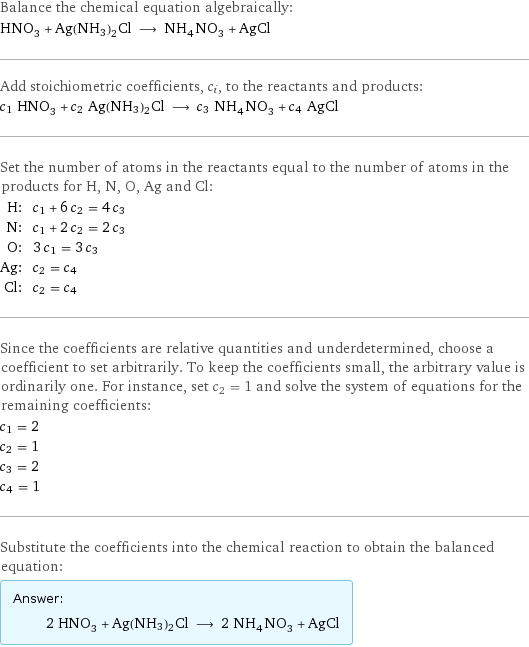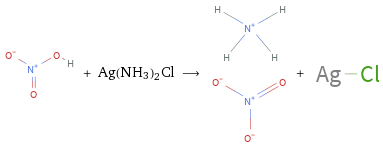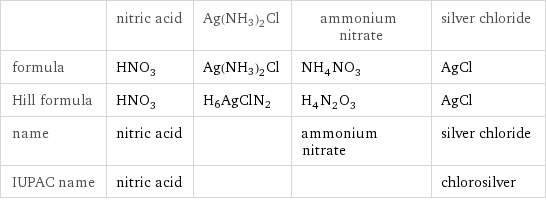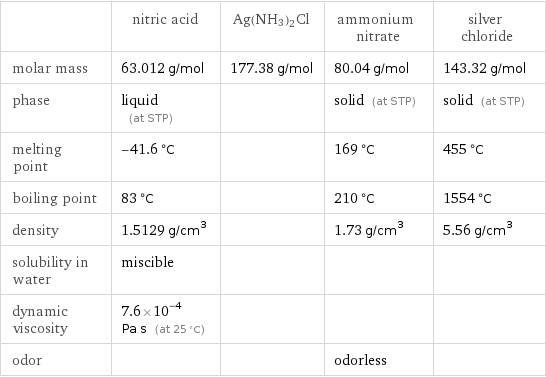Input interpretation

HNO_3 nitric acid + Ag(NH3)2Cl ⟶ NH_4NO_3 ammonium nitrate + AgCl silver chloride
Balanced equation

Balance the chemical equation algebraically: HNO_3 + Ag(NH3)2Cl ⟶ NH_4NO_3 + AgCl Add stoichiometric coefficients, c_i, to the reactants and products: c_1 HNO_3 + c_2 Ag(NH3)2Cl ⟶ c_3 NH_4NO_3 + c_4 AgCl Set the number of atoms in the reactants equal to the number of atoms in the products for H, N, O, Ag and Cl: H: | c_1 + 6 c_2 = 4 c_3 N: | c_1 + 2 c_2 = 2 c_3 O: | 3 c_1 = 3 c_3 Ag: | c_2 = c_4 Cl: | c_2 = c_4 Since the coefficients are relative quantities and underdetermined, choose a coefficient to set arbitrarily. To keep the coefficients small, the arbitrary value is ordinarily one. For instance, set c_2 = 1 and solve the system of equations for the remaining coefficients: c_1 = 2 c_2 = 1 c_3 = 2 c_4 = 1 Substitute the coefficients into the chemical reaction to obtain the balanced equation: Answer: | | 2 HNO_3 + Ag(NH3)2Cl ⟶ 2 NH_4NO_3 + AgCl
Structures

+ Ag(NH3)2Cl ⟶ +
Names

nitric acid + Ag(NH3)2Cl ⟶ ammonium nitrate + silver chloride
Equilibrium constant
![Construct the equilibrium constant, K, expression for: HNO_3 + Ag(NH3)2Cl ⟶ NH_4NO_3 + AgCl Plan: • Balance the chemical equation. • Determine the stoichiometric numbers. • Assemble the activity expression for each chemical species. • Use the activity expressions to build the equilibrium constant expression. Write the balanced chemical equation: 2 HNO_3 + Ag(NH3)2Cl ⟶ 2 NH_4NO_3 + AgCl Assign stoichiometric numbers, ν_i, using the stoichiometric coefficients, c_i, from the balanced chemical equation in the following manner: ν_i = -c_i for reactants and ν_i = c_i for products: chemical species | c_i | ν_i HNO_3 | 2 | -2 Ag(NH3)2Cl | 1 | -1 NH_4NO_3 | 2 | 2 AgCl | 1 | 1 Assemble the activity expressions accounting for the state of matter and ν_i: chemical species | c_i | ν_i | activity expression HNO_3 | 2 | -2 | ([HNO3])^(-2) Ag(NH3)2Cl | 1 | -1 | ([Ag(NH3)2Cl])^(-1) NH_4NO_3 | 2 | 2 | ([NH4NO3])^2 AgCl | 1 | 1 | [AgCl] The equilibrium constant symbol in the concentration basis is: K_c Mulitply the activity expressions to arrive at the K_c expression: Answer: | | K_c = ([HNO3])^(-2) ([Ag(NH3)2Cl])^(-1) ([NH4NO3])^2 [AgCl] = (([NH4NO3])^2 [AgCl])/(([HNO3])^2 [Ag(NH3)2Cl])](../image_source/43c07c81ff2025a04a6ed63b7e2d44dc.png)
Construct the equilibrium constant, K, expression for: HNO_3 + Ag(NH3)2Cl ⟶ NH_4NO_3 + AgCl Plan: • Balance the chemical equation. • Determine the stoichiometric numbers. • Assemble the activity expression for each chemical species. • Use the activity expressions to build the equilibrium constant expression. Write the balanced chemical equation: 2 HNO_3 + Ag(NH3)2Cl ⟶ 2 NH_4NO_3 + AgCl Assign stoichiometric numbers, ν_i, using the stoichiometric coefficients, c_i, from the balanced chemical equation in the following manner: ν_i = -c_i for reactants and ν_i = c_i for products: chemical species | c_i | ν_i HNO_3 | 2 | -2 Ag(NH3)2Cl | 1 | -1 NH_4NO_3 | 2 | 2 AgCl | 1 | 1 Assemble the activity expressions accounting for the state of matter and ν_i: chemical species | c_i | ν_i | activity expression HNO_3 | 2 | -2 | ([HNO3])^(-2) Ag(NH3)2Cl | 1 | -1 | ([Ag(NH3)2Cl])^(-1) NH_4NO_3 | 2 | 2 | ([NH4NO3])^2 AgCl | 1 | 1 | [AgCl] The equilibrium constant symbol in the concentration basis is: K_c Mulitply the activity expressions to arrive at the K_c expression: Answer: | | K_c = ([HNO3])^(-2) ([Ag(NH3)2Cl])^(-1) ([NH4NO3])^2 [AgCl] = (([NH4NO3])^2 [AgCl])/(([HNO3])^2 [Ag(NH3)2Cl])
Rate of reaction
![Construct the rate of reaction expression for: HNO_3 + Ag(NH3)2Cl ⟶ NH_4NO_3 + AgCl Plan: • Balance the chemical equation. • Determine the stoichiometric numbers. • Assemble the rate term for each chemical species. • Write the rate of reaction expression. Write the balanced chemical equation: 2 HNO_3 + Ag(NH3)2Cl ⟶ 2 NH_4NO_3 + AgCl Assign stoichiometric numbers, ν_i, using the stoichiometric coefficients, c_i, from the balanced chemical equation in the following manner: ν_i = -c_i for reactants and ν_i = c_i for products: chemical species | c_i | ν_i HNO_3 | 2 | -2 Ag(NH3)2Cl | 1 | -1 NH_4NO_3 | 2 | 2 AgCl | 1 | 1 The rate term for each chemical species, B_i, is 1/ν_i(Δ[B_i])/(Δt) where [B_i] is the amount concentration and t is time: chemical species | c_i | ν_i | rate term HNO_3 | 2 | -2 | -1/2 (Δ[HNO3])/(Δt) Ag(NH3)2Cl | 1 | -1 | -(Δ[Ag(NH3)2Cl])/(Δt) NH_4NO_3 | 2 | 2 | 1/2 (Δ[NH4NO3])/(Δt) AgCl | 1 | 1 | (Δ[AgCl])/(Δt) (for infinitesimal rate of change, replace Δ with d) Set the rate terms equal to each other to arrive at the rate expression: Answer: | | rate = -1/2 (Δ[HNO3])/(Δt) = -(Δ[Ag(NH3)2Cl])/(Δt) = 1/2 (Δ[NH4NO3])/(Δt) = (Δ[AgCl])/(Δt) (assuming constant volume and no accumulation of intermediates or side products)](../image_source/cfdc13d70b654009108de673d04a47d3.png)
Construct the rate of reaction expression for: HNO_3 + Ag(NH3)2Cl ⟶ NH_4NO_3 + AgCl Plan: • Balance the chemical equation. • Determine the stoichiometric numbers. • Assemble the rate term for each chemical species. • Write the rate of reaction expression. Write the balanced chemical equation: 2 HNO_3 + Ag(NH3)2Cl ⟶ 2 NH_4NO_3 + AgCl Assign stoichiometric numbers, ν_i, using the stoichiometric coefficients, c_i, from the balanced chemical equation in the following manner: ν_i = -c_i for reactants and ν_i = c_i for products: chemical species | c_i | ν_i HNO_3 | 2 | -2 Ag(NH3)2Cl | 1 | -1 NH_4NO_3 | 2 | 2 AgCl | 1 | 1 The rate term for each chemical species, B_i, is 1/ν_i(Δ[B_i])/(Δt) where [B_i] is the amount concentration and t is time: chemical species | c_i | ν_i | rate term HNO_3 | 2 | -2 | -1/2 (Δ[HNO3])/(Δt) Ag(NH3)2Cl | 1 | -1 | -(Δ[Ag(NH3)2Cl])/(Δt) NH_4NO_3 | 2 | 2 | 1/2 (Δ[NH4NO3])/(Δt) AgCl | 1 | 1 | (Δ[AgCl])/(Δt) (for infinitesimal rate of change, replace Δ with d) Set the rate terms equal to each other to arrive at the rate expression: Answer: | | rate = -1/2 (Δ[HNO3])/(Δt) = -(Δ[Ag(NH3)2Cl])/(Δt) = 1/2 (Δ[NH4NO3])/(Δt) = (Δ[AgCl])/(Δt) (assuming constant volume and no accumulation of intermediates or side products)
Chemical names and formulas

| nitric acid | Ag(NH3)2Cl | ammonium nitrate | silver chloride formula | HNO_3 | Ag(NH3)2Cl | NH_4NO_3 | AgCl Hill formula | HNO_3 | H6AgClN2 | H_4N_2O_3 | AgCl name | nitric acid | | ammonium nitrate | silver chloride IUPAC name | nitric acid | | | chlorosilver
Substance properties

| nitric acid | Ag(NH3)2Cl | ammonium nitrate | silver chloride molar mass | 63.012 g/mol | 177.38 g/mol | 80.04 g/mol | 143.32 g/mol phase | liquid (at STP) | | solid (at STP) | solid (at STP) melting point | -41.6 °C | | 169 °C | 455 °C boiling point | 83 °C | | 210 °C | 1554 °C density | 1.5129 g/cm^3 | | 1.73 g/cm^3 | 5.56 g/cm^3 solubility in water | miscible | | | dynamic viscosity | 7.6×10^-4 Pa s (at 25 °C) | | | odor | | | odorless |
Units
